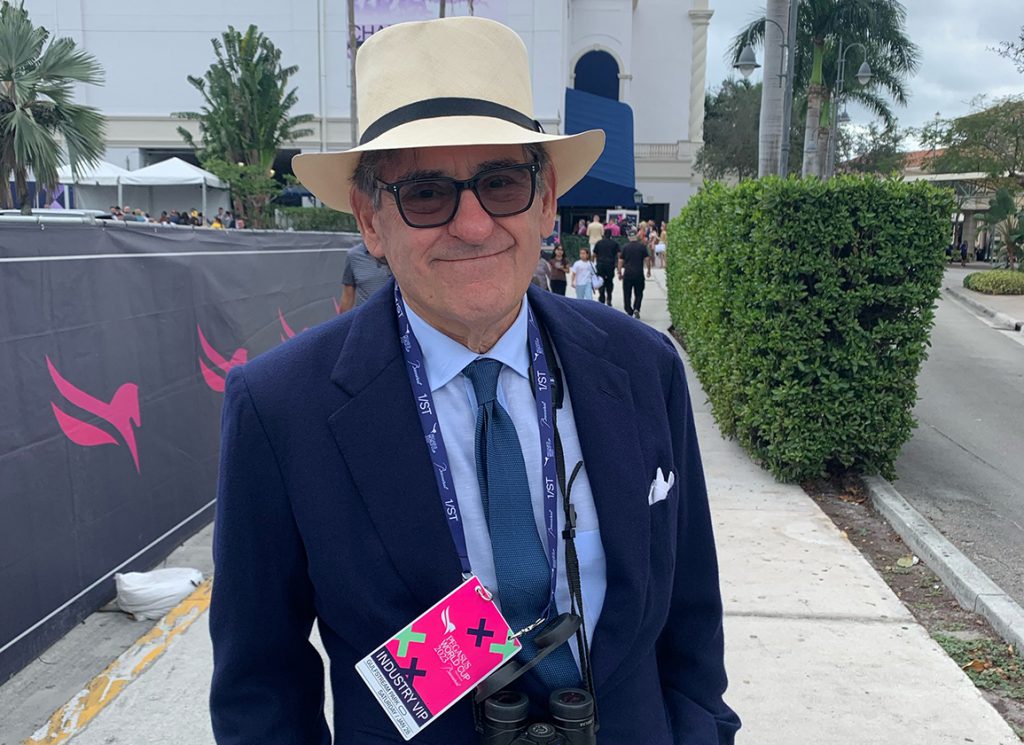A few weeks ago, I was a guest on the weekly Going In Circles podcast, which is hosted by Chuck Simon, the former trainer who’s also a top-notch writer at his blog, and Barry “The Sniper” Spears, an excellent handicapper and well-known figure on Twitter. Simon asked for my opinion on which stallion I’d consider to be the most influential of the past 50 years. You can listen to a nine-minute clip of the conversation here. My answer? Claiborne’s iconic Mr. Prospector, of course.
The clip generated quite a bit of interest and debate on social media. Simon kept Northern Dancer out of the equation, and I made my selection on North American-based stallions whose careers had begun within the 50-year window. Mr. Prospector, a son of Raise a Native from Gold Digger, by Nashua, was born in 1970–the same year as Secretariat and Forego–and entered stud in 1975 in Florida. This timeframe eliminated not only Northern Dancer but also Raise a Native, another icon.
Mr. Prospector’s stud career and substantial influence has been thoroughly documented through the years from the time he went to stud until his death in 1999 at the age of 29. All told, he sired 1,195 foals and 182 black-type winners, a ratio of 15% from foals– not starters. These days top stallions are lucky to hit 10%.
Fifty-odd years since his birth, Mr. Prospector’s influence is still palpable. Five of the top 10 sires on the general sire list of 2022– Quality Road, Curlin, Gun Runner, Speightstown, and Munnings–trace in tail-male descent to him, as do four of the top 10 broodmare sires–Street Cry (Ire), Smart Strike, Distorted Humor, and Unbridled’s Song.
In 2015, John Sparkman wrote a piece in Daily Racing Form titled “Mr. Prospector line has no American equal” that said in part, “…Mr. Prospector now stands at the head of the most successful classic sire line in the United States. His fifth-generation male-line descendant American Pharoah, who broke a 37-year Triple Crown drought with his Belmont Stakes victory on June 6, is the 32nd American classic winner descending in male line from Mr. Prospector dating back to when his son Conquistador Cielo won the Belmont in 1982.”
According to Sparkman, the Northern Dancer line was second to Mr. Prospector in this timeframe, with 17 Classic winners.
Since then, the Mr. Prospector line is responsible for an additional seven Classic winners in the U.S., the most recent of which was last year’s Gl Preakness winner Early Voting (Gun Runner). The Northern Dancer line also has had another seven.
If the Classics are the gauge, Mr. Prospector’s impact on them certainly makes him the most influential stallion of the last 50 years.
Florida to Claiborne
Mr. Prospector, who was bred by Leslie Combs ll, topped the 1971 Keeneland July sale at $220,000. He was purchased by A.I. “Butch” Savin’s AISCO Stable and trained by Jimmy Croll, but he wasn’t a Classic horse himself; he was sprinter, and a brilliantly fast one when he was sound. On the same day that Savin’s Regal and Royal won the Gl Florida Derby, defeating Forego by three lengths, Mr. Prospector set the track record for six furlongs at Gulfstream in 1:07 4/5, winning by nine lengths in his third start.
Mr. Prospector, who was unraced at two, would go on to win seven of 14 starts, including the Gravesend and Whirlaway while contemporaries Secretariat won the Triple Crown and Forego three Horse of the Year titles.
Mr. Prospector attained his legendary status in the breeding shed, and improbably at that. Savin retired him to stud inexpensively at his AISCO Stable in Florida, far away from the best broodmares in Kentucky, but Mr. Prospector simply had what it took to overcome lesser mares. From his first crop, he got 1978 Eclipse champion 2-year-old filly It’s in the Air, among others. Fappiano, a Grade l winner and top racehorse who became an influential stallion himself, was a member of Mr. Prospector’s second crop. Another future successful stallion, Grade l-placed Crafty Prospector, was from Mr. Prospector’s fourth crop.
Peter Brant, who picked up an Eclipse award for Regal Glory (Animal Kingdom) as top turf filly or mare last week, was among the first owner-breeders to notice Mr. Prospector’s prepotency and was instrumental in acquiring Mr. Prospector and moving him to Kentucky for the 1981 breeding season. I spoke last week to Brant, whose White Birch Farm is in Connecticut, of how he was able to move the stallion from AISCO to Claiborne.
“Butch Savin was in the concrete mix business in Connecticut. When he had Mr. Prospector, he lived in Connecticut and also in Boca Raton in Florida. I started to notice this horse was getting some nice horses from some cheap mares, as I was looking up stallion stats to see who to breed to, and this horse was looking very, very good, so I made it my business to meet Butch Savin. I would go down to Boca Raton, because at the time I was playing polo in Wellington. I kind of lived in Florida three months of the year while I was playing polo. So, I would go down to Boca–he had a condominium overlooking the ocean–and I would pick him up; he had a favorite Chinese restaurant and we would go there and sit and talk of the future plans of Mr. Prospector.
“I’d called Seth Hancock up and told him this horse was the real deal, and Seth was interested but the horse was in Florida and the horse was good with cheap mares but would he do well on the Kentucky circuit against those other stallions, especially the ones Seth was carrying at the time,” Brant said.
“Anyway, I’m talking to Butch and I tell him why don’t we move the horse to Kentucky, and he says, ‘Well, I’m not going to move. I have a farm in Florida.’ And I said, ‘Why don’t you stay in on the horse, and we’ll move him to Kentucky?’ So, I’m talking to Seth and Butch Savin–it was really like arbitraging Seth and Butch Savin–and it wasn’t the easiest job in the world. Finally, Butch agreed to move the horse to Kentucky and said he would stay in on the horse. I was going to keep like a third of the horse, and Seth was going to syndicate the rest of him. You know, Seth did a great job syndicating him–he had the best owners in there. And then Savin says, ‘I don’t want to stay in on the horse. I’m not, realistically, going to send any mares up to Kentucky.’ So, he didn’t stay in. And we paid real money for the horse. It was probably between $175,000 to $200,000 per share, and there were 40 shares.
“I ended up keeping a third, and as the prices went up I’d spin off some shares. You know, at one point he was standing for $300,000 no guarantee. He was a very valuable horse, and what made him a great investment for everybody involved was that the shares went to over a million dollars. And what made him even more valuable was he was one of the few stallions who was breeding to more mares back then, and so you basically got an extra season every other year. Back then, horses were breeding 40 to 48 mares, and he was breeding 64, 65 mares, up to 70. And so it was a very good deal, and he also lived a very long life and was fertile for a long time.”
And he sired some of the best colts and fillies of his era, and they in turn became sires and dams of other high-quality stock, and the cycle kept continuing.
And it keeps continuing, which is why Mr. Prospector is the most influential sire of the last 50 years in North America.
Sid Fernando is president and CEO of Werk Thoroughbred Consultants, Inc., originator of the Werk Nick Rating and eNicks.
The post Taking Stock: Mr. Prospector is the Most Influential appeared first on TDN | Thoroughbred Daily News | Horse Racing News, Results and Video | Thoroughbred Breeding and Auctions.







